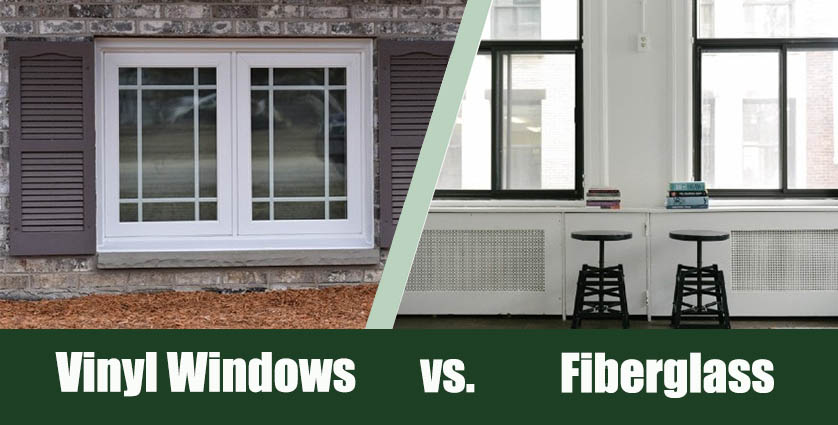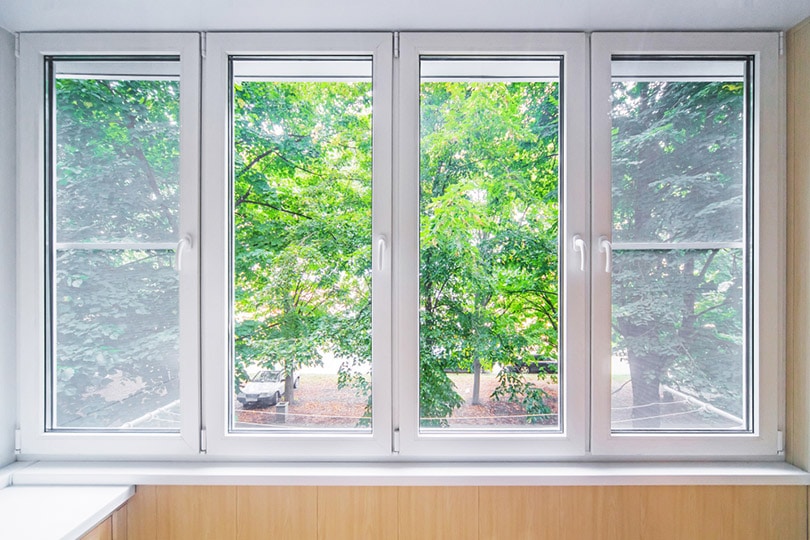Vinyl Vs Fiberglass Windows: Pros, Cons, & Differences
-
Pete Ortiz
- Last updated:

Vinyl and fiberglass represent two of the most popular modern window materials. They are both considered cost effective and convenient alternatives to wood: neither of them requiring much in the way of annual maintenance or stripping and painting. However, while fiberglass allows for thinner frames while still offering greater energy efficiency, it is more expensive than vinyl windows and installation costs are also much higher. There are differences in design and maintenance, too.
Read on for general information on these two popular window materials, the pros and cons of each, and to help determine which is the best choice for your next window installation.
Overview of Vinyl Windows:
Vinyl windows are made from a material called Poly-Vinyl Chloride. Effectively, the windows are made from a blend of PVC and other materials that make it easier to manufacture and turn into window frames.
Although vinyl windows were first manufactured in the 1960s, it wasn’t until the 1970s when they became popular. They were seen as a popular replacement for wooden windows because they offer greater energy efficiency and are more cost-effective than wood. More than half of new windows installed today are vinyl windows.
Installation and Costs
Manufacturing vinyl windows is considered easy, and so too is installation. Because this material is so commonplace within the industry, and because it is easy to install, the cost of these windows is usually much cheaper than fiberglass, aluminum, or wood windows. Although it is best left to experienced installers, it is feasibly possible to install vinyl windows yourself if you have experience doing so. PVC itself is also inexpensive and easy to work with, which means that these tend to be the cheapest windows to buy, even excluding installation costs.
Durability
Durability goes hand in hand with cost because if a cheap window only lasts a few years, it will need replacing and the costs soon add up. Top-quality vinyl windows can last as long as 30 years, although you should expect to have to replace them in around 20 years. While this is a decent lifespan, vinyl does not last as long as fiberglass.
Appearance
Wood windows are what most people consider to be traditional windows, but vinyl has been around for more than 50 years and is, itself, considered traditional. The windows do come in a variety of colors, although white is certainly the most common, and they can come with a wood-like texture. The frames are quite thick, but they are also hollow so they can be filled with insulation.
Vinyl does not need painting, which is great because it means you don’t have to worry about having to strip the paint back and recover every year. It is also a detriment because it means that you are stuck with the original finish that you had when installed. It also means that if any damage does occur, you will have to pay for repairs rather than try to cover them up.

Energy Efficiency
Windows are the biggest energy drain in a home if they are not energy efficient. The frames can be insulated, and very-good quality vinyl windows do a decent job of preventing heat loss. There are more energy efficient alternatives available.
- No need for annual painting
- Frames can be insulated
- Low purchase cost
- Low installation cost
- You’re stuck with the original color or design
- Not as energy efficient as other materials
- Typically made with wide frames
Overview of Fiberglass Windows:
Fiberglass is a plastic material that has been reinforced with glass fibers. Fiberglass windows were made to withstand heat and cold and as a means of preventing heat loss from properties. The strength of the material means that fiberglass frames can be very thin, and they can also take paint so you don’t have to be stuck with the same look for the next 50 years, which is roughly how long windows will last. However, fibreglass is not as flexible or easy to work with as vinyl. The windows are expensive, and so too is the cost of installation.

Installation and Costs
Fiberglass windows are expensive, costing as much as double the price of vinyl windows. The inflexibility of the material also makes installation more difficult, and this not only makes DIY installation very risky, but it roughly doubles the cost of having them professionally installed as well. It is worth bearing in mind, however, that the durability and longevity of fiberglass means that it can work out cheaper over a 40- or 50-year period.
Durability
Fiberglass does not warp or crack, even after decades of use, and it will withstand hot and cold, as well as regular temperature changes between the two extremes. This means that fiberglass windows can last as long as 50 years and it will continue to offer the same thermal insulation throughout its life.
Appearance
Fiberglass is stronger than vinyl, which means that manufacturers can produce much smaller and narrower frames. This is especially beneficial in large windows because the glazing itself will be the focal point and there won’t be an overabundance of plastic frame. The material also retains paint, which means that, if you want to change the color or appearance of the frames after 5 years, you can do. There is also a good variety of styles, colors, and textures to choose from when purchasing.
Energy Efficiency
Fiberglass has been reinforced with glass fibers, and glass is an excellent insulator. This means that fiberglass windows will not allow heat to escape your home, reducing energy bills and prevent cold spots around the windows. However, the frames cannot usually be filled with additional insulation.
- 50-year life
- Can be painted to change the appearance
- Small frames give a minimalist look
- Very energy efficient
- Expensive to buy
- Expensive to install
Vinyl Or Fiberglass – Cost
Which material is best for you depends on your circumstances and requirements. In terms of cost, vinyl windows are cheaper to buy and cheaper to install. However, they have a life of approximately 25 years, compared to the 50 years of fiberglass, so they will need replacing twice as often.
If you intend to stay in the property for more than 20 years, and you have the budget, fiberglass is likely your best option. If you are looking to save money, or you won’t be staying in the property that long, vinyl windows are better for you.
Vinyl Or Fiberglass – Durability
Vinyl windows are strong and durable and are expected to last at least 20 years. More often than not, they will last 25 years, and really good quality vinyl windows can last 30 years. However, the vinyl does expand and contract over time and with changing atmospheric conditions. This not only means that they will eventually crack but it means that the insulation layer can degrade over time.
Fiberglass is stronger, does not contract and expand, and will last 50 years. Fiberglass is more durable and has a longer life.
Viny Or Fiberglass – Appearance
Again, when it comes to appearance, the choice of which window material is better will come down to your circumstances. Vinyl windows have been around for more than 50 years and this, combined with the flexibility of the material itself, means that there is a huge range of styles, colors, and textures available. However, vinyl windows cannot be painted, which means that you are stuck with the color you choose until you replace the windows.
Fiberglass does come in a decent range of colors, although not yet as expansive as is available for vinyl. But the frames are thinner, which some people prefer, and the fiberglass accepts and retains paint, so you can chance the color whenever you like.
Vinyl Or Fiberglass – Energy Efficiency
One of the most important factors to consider when choosing windows is their energy efficiency because so much energy can be lost through poorly insulated windows. Vinyl windows are good at insulating, especially if the frame is filled with insulator, but fiberglass is considered 15% more efficient than vinyl and wins out in the competition for greater efficiency.
Conclusion
Vinyl and fiberglass are two of the most common choices in modern window material and both represent a good alternative to wood. Fiberglass is more energy efficient, lasts longer, and can be painted to change its color and style, but that comes at a cost because fiberglass windows are more expensive to buy and to install. Consider what is most important to you, and how long you will be in the property, when you decide on the type of windows you have installed.
See Also:
- Soft-Lite Windows vs Pella: Pros, Cons, & Differences?
- Wallside Windows vs Hansons Windows: Pros, Cons, and Differences
Featured Image Credit: Left: Gina Leonard, Shutterstock. Right: Piqsels
Contents




